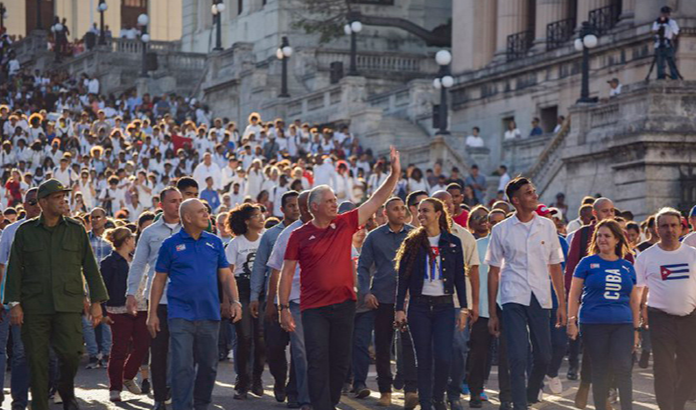
The march started from the steps of the University of Havana. Photo: Luis Jiménez Echevarría
Havana, November 28 (RHC)-- The First Secretary of the Central Committee of the Communist Party of Cuba (PCC) and President of the Republic, Miguel Díaz-Canel accompanied thousands of young people who took part on Wednesday in the traditional pilgrimage for the 153rd anniversary of the shooting of the eight medical students at the hands of Spanish colonialism.
Also present at the march, which started from the steps of the University of Havana to the monument that commemorates the vile murder, located at Prado and Malecón, were Roberto Morales Ojeda, member of the Political Bureau and Secretary of Organization of the Central Committee of the PCC; Meyvis Estévez Echeverría, first secretary of the National Committee of the Union of Young Communists, among other representatives of the Party, the Government and mass and student organizations.
The national president of the Federation of University Students (FEU), Ricardo Rodríguez González, referred to the pain that these events awaken, which affects Cuban youth today and their will to protest against any similar injustice.
He affirmed that those who intend to subdue the Cuban nation and hand it over to the anti-Martian project of servility will be opposed by this same youth that honors its dead and does not forget the cruelty of the crime and its perpetrators.
“We are called by the history of this revolutionary staircase and always an accomplice of the Cuban student movement and a platform of condemnation against injustices such as the blockade imposed by the United States Government and the Zionist genocide in Palestine,” he added.
For Diana Duhaldeborde, a second-year student at the Faculty of Medical Sciences at the ‘Comandante Manuel Fajardo’ Clinical-Surgical University Hospital, this particular page of Cuban history reaffirms the rejection of injustices by the new generations, both those that occurred a hundred years ago and those of today.
As a future doctor, she expressed her willingness to pay tribute with her professional conduct to the memory of those who fell then and proudly highlighted how this feeling expands with the humanist, supportive and internationalist vocation of the revolutionary process, embodied in her doctors.
On November 24, 1871, students of the first year of Medicine were waiting in the Anatomical Amphitheater for the arrival of their professor Pablo Valencia, who was to give a class, but upon learning that he would be late, several of them decided to attend the dissection practices of Dr. Domingo Fernández Cubas.
According to historical notes, some of them entered the cemetery, located near the school, and walked around its courtyards, since entry was not prohibited, and one of them, Alonso Álvarez de la Campa, took a flower that was in front of the cemetery offices, which provoked the anger of the caretaker, named Vicente Cobas.
He accused them of scratching the glass that covered the niche where the remains of the Spanish journalist Gonzalo Castañón, director of La Voz de Cuba, spokesman for the volunteer corps, who had been killed by a Cuban patriot in Key West, United States, rested.
The students were arrested and tried in a summary trial, but the verdict was not accepted, and a second trial was held in which it was determined to sentence the young men to the maximum penalty, while three others were chosen at random to satisfy the volunteers' demands for blood.
The eight students sentenced to death were taken three days later, on November 27, 1871, to the esplanade of La Punta, where the execution took place, considered one of the most atrocious crimes committed on the island by Spanish colonialism. (Source: ACN)

